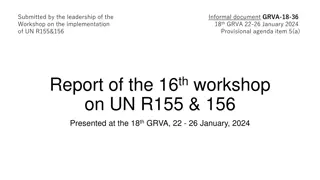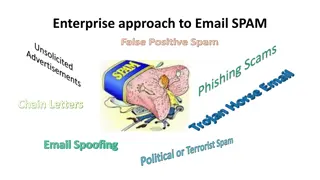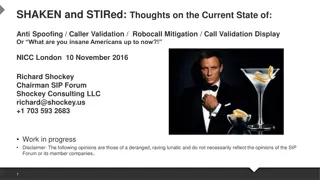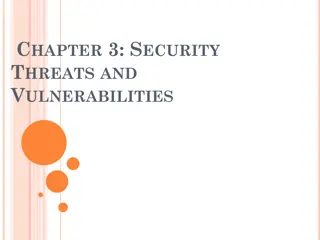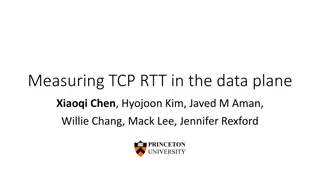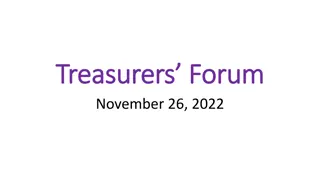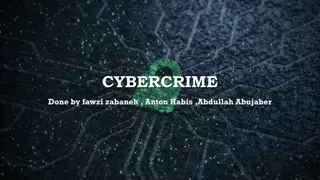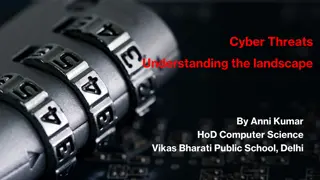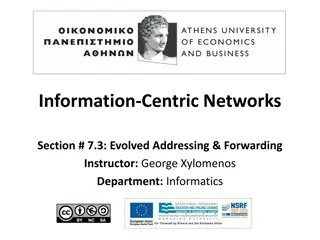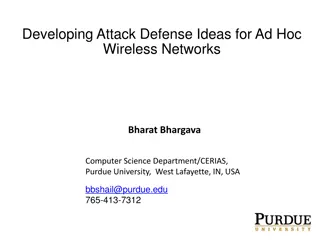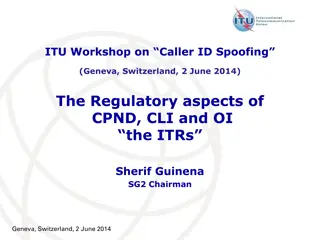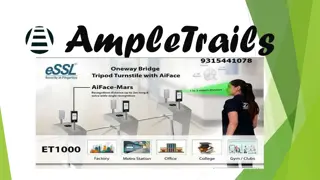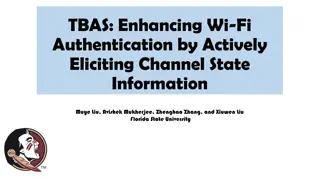Workshop Report on Implementation of UN Regulations R155 & R156
The report presents key discussions from the 16th workshop on UN Regulations R155 & R156, covering topics such as GNSS spoofing, reporting provisions, software updates, and recertification processes for CSMS/SUMS. It highlights the need for risk assessment, annual reporting, software obligations, an
0 views • 11 slides
Enhancing Secure Telephone Identity and Caller Authentication
The STIR Working Group aims to address the issues surrounding the reliability of caller identities in telecommunication networks. By specifying internet-based mechanisms for verifying the authorization of calling parties, STIR seeks to combat threats like caller ID spoofing and unauthorized use of t
0 views • 11 slides
Understanding Enterprise Email Spam Prevention Techniques
Learn about the key strategies used by enterprises to combat email spam, including spam filters, SPF records, DMARC, DKIM, whitelisting, and SCL ratings. Discover how these tools work together to protect against spam, spoofing, and phishing attempts.
0 views • 8 slides
SHAKEN and STIRed: Current State of Anti-Spoofing and Robocall Mitigation
Exploring the challenges and efforts in combatting robocalls and caller spoofing in the telecommunications industry, focusing on restoring trust in voice networks through initiatives like SHAKEN (Secure Handling of Asserted information using toKENs) and STIR (Secure Telephone Identity Revisited). Th
0 views • 22 slides
Understanding Security Threats and Vulnerabilities in Computer Systems
In computer security, threats exploit vulnerabilities to breach security and cause harm. Vulnerabilities arise from system weaknesses, attacker access, and capability. Threats include spoofing, data tampering, repudiation, information disclosure, denial of service, and elevation of privilege. Catego
0 views • 13 slides
Understanding TCP Round-Trip Time Measurement
This presentation delves into the importance of measuring TCP round-trip time in the data plane, highlighting key reasons such as security against BGP hijacks and IP spoofing, performance enhancements, and improving user Quality of Experience. It explores monitoring at a vantage point, TCP sequence
0 views • 12 slides
Financial Management and Cybersecurity: Essential Tips for Treasurers
A comprehensive guide covering topics such as budget development, treasurer's role responsibilities, and cybersecurity basics for treasurers. Learn about financial sustainability, board commitments, and protecting against cybersecurity threats like ransomware and spoofing scams. These insights aim t
0 views • 13 slides
Understanding Network Security Vulnerabilities and Attacks
Explore the world of network security vulnerabilities and attacks, including Denial-of-Service (DoS) and Distributed-Denial-of-Service (D-DoS), security flaws in the TCP/IP protocol suite, ICMP attacks, routing attacks, and TCP attacks. Learn about common security vulnerabilities such as address spo
0 views • 36 slides
Understanding Cybercrime: Types, Signs, and Prevention
Cybercrime involves various criminal activities targeting computers and networks, aiming to generate profit or cause harm. Types include website spoofing, ransomware, malware, IoT hacking, identity theft, and online scams. Signs of identity theft can manifest in credit, tax, child, medical, and crim
0 views • 6 slides
Understanding Cyber Threats in Today's Digital Landscape
Cyberspace is a vast realm encompassing the Internet, where we engage in various activities ranging from communication to entertainment. With the majority of children exposed to the online world, cybersecurity awareness is crucial to tackle the rising cyber threats. These threats include job frauds,
0 views • 33 slides
Evolved Addressing and Forwarding in Information-Centric Networks
The content discusses Evolved Addressing and Forwarding in Information-Centric Networks, focusing on an accountable Internet protocol (AIP) that addresses vulnerabilities at the IP level, such as source spoofing, DoS attacks, and route hijacking. AIP utilizes a hierarchy of self-certifying addresses
0 views • 16 slides
Developing Attack Defense Ideas in Ad Hoc Wireless Networks
This research delves into the challenges and security threats faced by ad hoc wireless networks, particularly in the context of connected vehicles. It explores various attacks such as distributed denial-of-service, spoofing, replay, and more, and aims to measure the impact of implementing security m
0 views • 30 slides
Regulatory Aspects of CPND, CLI, and OI in ITU Workshop on Caller ID Spoofing
The ITU Workshop on Caller ID Spoofing in Geneva addressed the regulatory aspects of Calling Party Number Delivery (CPND), Calling Line Identification (CLI), and Origin Identification (OI) in the context of the International Telecommunications Regulations (ITRs). Divergent views were discussed regar
0 views • 12 slides
Advanced AI Facial Recognition System with Turnstile Features
A comprehensive overview of the advanced AI facial recognition system - AIFACE-MARS, showcasing its unique features such as visible light facial recognition, anti-spoofing algorithms, multiple verification methods, hardware specifications, and integrated one-way bridge tripod turnstile features. The
0 views • 9 slides
Enhancing Wi-Fi Authentication Using Channel State Information
This research discusses enhancing Wi-Fi authentication by actively eliciting channel state information (CSI) to detect spoofing attacks. The challenge lies in obtaining the legitimate user's CSI and comparing it in real-time due to changing CSI and user traffic variations. The proposed approach invo
0 views • 27 slides
